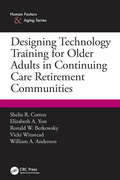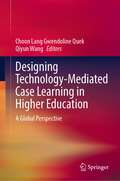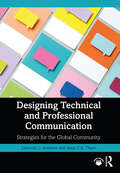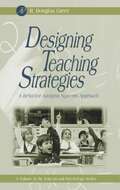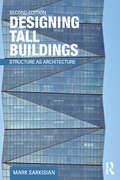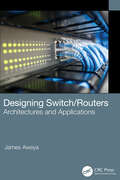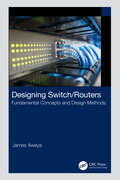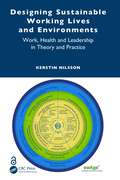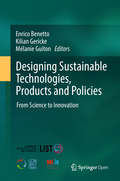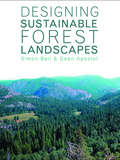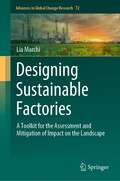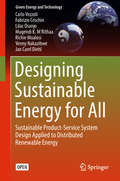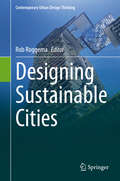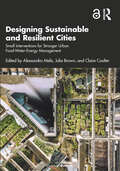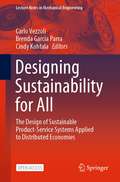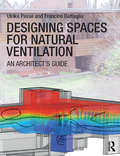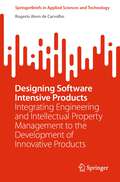- Table View
- List View
Designing Technology Training for Older Adults in Continuing Care Retirement Communities
by Shelia R. Cotten Elizabeth A. Yost Ronald W. Berkowsky Vicki Winstead William A. AndersonThis book provides the latest research and design-based recommendations for how to design and implement a technology training program for older adults in Continuing Care Retirement Communities (CCRCs). The approach in the book concentrates on providing useful best practices for CCRC owners, CEOs, activity directors, as well as practitioners and system designers working with older adults to enhance their quality of life. Educators studying older adults will also find this book useful Although the guidelines are couched in the context of CCRCs, the book will have broader-based implications for training older adults on how to use computers, tablets, and other technologies.
Designing Technology-Mediated Case Learning in Higher Education: A Global Perspective
by Choon Lang Gwendoline Quek Qiyun WangThis book collects case studies in design and application of technology-mediated case-based learning models in higher education. It provides a much-needed, updated synthesis of recent research and application of technology-mediated case-based learning across disciplines within higher education. The book does not only provide a broad perspective and deep understanding on the designs and instructional applications of technology-mediated case-based learning models, but also inspire more interest in adopting or inventing new situated case-based learning models in the context of higher education.
Designing Technical and Professional Communication: Strategies for the Global Community
by Deborah C. Andrews Jason C. ThamThis concise and flexible core textbook integrates a design thinking approach, rhetorical strategies, and a global perspective to help students succeed as technical and professional communicators in today’s multimodal, mobile, and global community. Design thinking and good communication practices are rooted in empathy and human values. The integrated approach fosters students' ability to address the complex problems they will face in their careers, where they will collaborate with people who present diverse expertise, cultures, languages, and values. This book introduces the knowledge and skills as well as agile activities that help students communicate on projects within local and global communities. Parts 1 and 2 introduce the strategies for design thinking, audience analysis, communicating ethically, collaborating professionally, and managing projects to define problems and implement solutions. In Parts 3 and 4, students learn to compose content in text and visuals. They learn to structure and deliver content by choosing the right genre and selecting effectively from the communication options available in today's multimodal environment. Designing Technical and Professional Communication serves as a flexible core textbook for technical and professional communication courses. An instructor’s manual containing exercises, sample syllabus, and guidance for teaching in a variety of settings is available online at www.routledge.com/9780367549602.
Designing Technical and Professional Communication: Strategies for the Global Community
by Deborah C. Andrews Jason C. ThamThis concise and flexible core textbook integrates a design thinking approach, rhetorical strategies, and a global perspective to help students succeed as technical and professional communicators in today’s multimodal, mobile, and global community. Design thinking and good communication practices are rooted in empathy and human values. The integrated approach fosters students' ability to address the complex problems they will face in their careers, where they will collaborate with people who present diverse expertise, cultures, languages, and values. This book introduces the knowledge and skills as well as agile activities that help students communicate on projects within local and global communities. Parts 1 and 2 introduce the strategies for design thinking, audience analysis, communicating ethically, collaborating professionally, and managing projects to define problems and implement solutions. In Parts 3 and 4, students learn to compose content in text and visuals. They learn to structure and deliver content by choosing the right genre and selecting effectively from the communication options available in today's multimodal environment. Designing Technical and Professional Communication serves as a flexible core textbook for technical and professional communication courses. An instructor’s manual containing exercises, sample syllabus, and guidance for teaching in a variety of settings is available online at www.routledge.com/9780367549602.
Designing Teaching Strategies: An Applied Behavior Analysis Systems Approach (ISSN)
by R. Douglas GreerThe US Dept. of Education, in conjunction with the US Dept. of Health and Human Services, recently unveiled a $50 million effort to expand research on early childhood cognitive development. A key issue identified requiring more information and research was the education and professional development of educators. Along these lines, Doug Greer has prepared a book discussing how best to teach, how to design functional curricula, and how to support teachers in using state-of-the-art science instruction materials. The book provides important information both to trainers of future teachers, current teachers, and to supervisors and policy makers in education. To trainers there is information on how to motivate, mentor, and instruct in-service teachers to use the best scientifically based teaching strategies and tactics. To in-service teachers, there is information on how to provide individualized instruction in classrooms with multiple learning and behavior problems, school interventions to help prevent vandalism and truancy, and how curricula and instruction can be designed to teach functional repetoirs rather than inert ideas. To policy makers and supervisors, the book discusses how to determine the effectiveness of curricular innitiatives toward meeting mandated standards in national assessments.Doug Greer was recently awarded the Fred S. Keller Award for Distinguished Contributions to Education by APA for the research and application of the material covered in this book. School programs incorporating the material used in this book have produced 4-7 times more learning outcomes for students than control and baseline educational programs (see www.cabas.com)The book provides research-based and field-tested procedures for:* Teaching students of all ability levels ranging from preschool to secondary school* How to teach special education students in the context of a regular classroom* Best practices for all teachers to teach more effectively* Means of monitoring and motivating teachers' practices* A comprehensive and system-wide science of teaching—post modern-postmodern!* Tested procedures that result in four to seven times more learning for allstudents* Tested procedures for supervisors to use with teachers that result insignificant student learning* Tested procedures for providing the highest accountability* A systems approach for schooling problems that provide solutions ratherthan blame* Parent approved and parent requested educational practices* Means for psychologists to work with teachers and students to solvebehavior and learning problems* A comprehensive systems science of schooling* An advanced and sophisticated science of pedagogy and curriculum design* Students who are not being served with traditional education can meet orexceed the performance of their more fortunate peers,* Supervisors can mentor teachers and therapists to provide state of thescience instruction* Parent education can create a professional setting for parents, educators,and therapists to work together in the best interests of the student,* Teachers and supervisors who measure as they teach produce significantlybetter outcomes for students,* Systemic solutions to instructional and behavioral problems involvingteachers, parents, supervisors provide means to pursue problems to theirsolution,* A science of teaching, as opposed to an art of teaching, can provide aneducational system that treats the students and the parents as the clients.
Designing Tall Buildings: Structure as Architecture
by Mark SarkisianThis second edition of Designing Tall Buildings, an accessible reference to guide you through the fundamental principles of designing high-rises, features two new chapters, additional sections, 400 images, project examples, and updated US and international codes. Each chapter focuses on a theme central to tall-building design, giving a comprehensive overview of the related architecture and structural engineering concepts. Author Mark Sarkisian, PE, SE, LEED® AP BD+C, provides clear definitions of technical terms and introduces important equations, gradually developing your knowledge. Projects drawn from SOM’s vast portfolio of built high-rises, many of which Sarkisian engineered, demonstrate these concepts. This book advises you to consider the influence of a particular site's geology, wind conditions, and seismicity. Using this contextual knowledge and analysis, you can determine what types of structural solutions are best suited for a tower on that site. You can then conceptualize and devise efficient structural systems that are not only safe, but also constructible and economical. Sarkisian also addresses the influence of nature in design, urging you to integrate structure and architecture for buildings of superior performance, sustainability, and aesthetic excellence.
Designing Tall Buildings: Structure as Architecture
by Mark SarkisianThis second edition of Designing Tall Buildings, an accessible reference to guide you through the fundamental principles of designing high-rises, features two new chapters, additional sections, 400 images, project examples, and updated US and international codes. Each chapter focuses on a theme central to tall-building design, giving a comprehensive overview of the related architecture and structural engineering concepts. Author Mark Sarkisian, PE, SE, LEED® AP BD+C, provides clear definitions of technical terms and introduces important equations, gradually developing your knowledge. Projects drawn from SOM’s vast portfolio of built high-rises, many of which Sarkisian engineered, demonstrate these concepts. This book advises you to consider the influence of a particular site's geology, wind conditions, and seismicity. Using this contextual knowledge and analysis, you can determine what types of structural solutions are best suited for a tower on that site. You can then conceptualize and devise efficient structural systems that are not only safe, but also constructible and economical. Sarkisian also addresses the influence of nature in design, urging you to integrate structure and architecture for buildings of superior performance, sustainability, and aesthetic excellence.
Designing Switch/Routers: Architectures and Applications
by James AweyaThis book focuses on the design goals (i.e., key features), architectures, and practical applications of switch/routers in IP networks. The discussion includes some practical design examples to illustrate how switch/routers are designed and how the key features are implemented. Designing Switch/Routers: Architectures and Applications explains the design and architectural considerations as well as the typical processes and steps used to build practical switch/routers. The author describes the components of a switch/router that are used to configure, manage, and monitor it. This book discusses the advantages of using Ethernet in today’s networks and why Ethernet continues to play a large role in Local Area Network (LAN), Metropolitan Area Network (MAN), and Wide Area Network (WAN) design. The author also explains typical networking applications of switch/routers, particularly in enterprise and internet service provider (ISP) networks. This book provides a discussion of the design of switch/routers and is written to appeal to undergraduate and graduate students, engineers, and researchers in the networking and telecom industry as well as academics and other industry professionals. The material and discussion are structured to serve as standalone teaching material for networking and telecom courses and/or supplementary material for such courses.
Designing Switch/Routers: Fundamental Concepts and Design Methods
by James AweyaThis book examines the fundamental concepts and design methods associated with switch/routers. It discusses the main factors that are driving the changing network landscape and propelling the continuous growth in demand for bandwidth and high-performance network devices. Designing Switch/Routers: Fundamental Concepts and Design Methods focuses on the essential concepts that underlie the design of switch/routers in general. This book considers the switch/router as a generic Layer 2 and Layer 3 forwarding device without placing an emphasis on any particular manufacturer’s device. The underlying concepts and design methods are not only positioned to be applicable to generic switch/routers but also to the typical switch/routers seen in the industry. The discussion provides a better insight into the protocols, methods, processes, and tools involved in designing switch/routers. The author discusses the design goals and features switch/router manufacturers consider when designing their products as well as the advanced and value-added features, along with the steps, used to build practical switch/routers. The last two chapters discuss real-world 6 switch/router architectures that employ the concepts and design methods described in the previous chapters. This book provides an introductory level discussion of switch/routers and is written in a style accessible to undergraduate and graduate students, engineers, and researchers in the networking and telecoms industry as well as academics and other industry professionals. The material and discussion are structured to serve as standalone teaching material for networking and telecom courses and/or supplementary material for such courses.
Designing Switch/Routers: Fundamental Concepts and Design Methods
by James AweyaThis book examines the fundamental concepts and design methods associated with switch/routers. It discusses the main factors that are driving the changing network landscape and propelling the continuous growth in demand for bandwidth and high-performance network devices. Designing Switch/Routers: Fundamental Concepts and Design Methods focuses on the essential concepts that underlie the design of switch/routers in general. This book considers the switch/router as a generic Layer 2 and Layer 3 forwarding device without placing an emphasis on any particular manufacturer’s device. The underlying concepts and design methods are not only positioned to be applicable to generic switch/routers but also to the typical switch/routers seen in the industry. The discussion provides a better insight into the protocols, methods, processes, and tools involved in designing switch/routers. The author discusses the design goals and features switch/router manufacturers consider when designing their products as well as the advanced and value-added features, along with the steps, used to build practical switch/routers. The last two chapters discuss real-world 6 switch/router architectures that employ the concepts and design methods described in the previous chapters. This book provides an introductory level discussion of switch/routers and is written in a style accessible to undergraduate and graduate students, engineers, and researchers in the networking and telecoms industry as well as academics and other industry professionals. The material and discussion are structured to serve as standalone teaching material for networking and telecom courses and/or supplementary material for such courses.
Designing Switch/Routers: Architectures and Applications
by James AweyaThis book focuses on the design goals (i.e., key features), architectures, and practical applications of switch/routers in IP networks. The discussion includes some practical design examples to illustrate how switch/routers are designed and how the key features are implemented. Designing Switch/Routers: Architectures and Applications explains the design and architectural considerations as well as the typical processes and steps used to build practical switch/routers. The author describes the components of a switch/router that are used to configure, manage, and monitor it. This book discusses the advantages of using Ethernet in today’s networks and why Ethernet continues to play a large role in Local Area Network (LAN), Metropolitan Area Network (MAN), and Wide Area Network (WAN) design. The author also explains typical networking applications of switch/routers, particularly in enterprise and internet service provider (ISP) networks. This book provides a discussion of the design of switch/routers and is written to appeal to undergraduate and graduate students, engineers, and researchers in the networking and telecom industry as well as academics and other industry professionals. The material and discussion are structured to serve as standalone teaching material for networking and telecom courses and/or supplementary material for such courses.
Designing Sustainable Working Lives and Environments: Work, Health and Leadership in Theory and Practice
by Kerstin NilssonWork is central to people’s lives and the course of their life. The opportunities and chances an individual can have in their life are significantly connected to work. Individuals' work is also crucial for organisations, companies and for the whole of society. There is a constant need to make changes and readjustments of working life since these can deeply affect the individual and their employability. To make working lives more healthy, sustainable and attractive, being aware of the measures and changes that can be achieved in practice is of crucial importance. This book bridges the gap between the theories and explanatory models offered in research and actual work environments and workplaces.This book constitutes a theoretical framework that visualises the complexity of working life and increases the knowledge and awareness of individuals, companies, organisations and society regarding different factors and patterns. It aims to support individual reflections and joint discussions into daily operations on the individual, organisational and societal level. This book contains practical tools to use in daily working life that analyse possible risks in the work environment when planning measures and actions for health promotion. These practical tools are derived from the four spheres for action and employability in the SwAge model. Developed by the author, the SwAge model (Sustainable Working Life for All Ages) is a theoretical, explanatory model that explains the complexity of creating a healthy and sustainable working life for all ages. By using the SwAge model as a comprehensible framework, the reader will be able to visualise the complexity of factors that affect and influence whether people are able to and want to participate in working life and in the work environment, thereby contributing to increased employability.Designing Sustainable Working Lives and Environments is an essential read for students, researchers, work environment engineers, ergonomics and human factor specialists, occupational health and safety practitioners, business managers, HR staff, leadership decision-makers and labour union professionals.The Open Access version of this book, available at http://www.taylorfrancis.com, has been made available under a Creative Commons Creative Commons Attribution (CC-BY) 4.0 license
Designing Sustainable Working Lives and Environments: Work, Health and Leadership in Theory and Practice
by Kerstin NilssonWork is central to people’s lives and the course of their life. The opportunities and chances an individual can have in their life are significantly connected to work. Individuals' work is also crucial for organisations, companies and for the whole of society. There is a constant need to make changes and readjustments of working life since these can deeply affect the individual and their employability. To make working lives more healthy, sustainable and attractive, being aware of the measures and changes that can be achieved in practice is of crucial importance. This book bridges the gap between the theories and explanatory models offered in research and actual work environments and workplaces.This book constitutes a theoretical framework that visualises the complexity of working life and increases the knowledge and awareness of individuals, companies, organisations and society regarding different factors and patterns. It aims to support individual reflections and joint discussions into daily operations on the individual, organisational and societal level. This book contains practical tools to use in daily working life that analyse possible risks in the work environment when planning measures and actions for health promotion. These practical tools are derived from the four spheres for action and employability in the SwAge model. Developed by the author, the SwAge model (Sustainable Working Life for All Ages) is a theoretical, explanatory model that explains the complexity of creating a healthy and sustainable working life for all ages. By using the SwAge model as a comprehensible framework, the reader will be able to visualise the complexity of factors that affect and influence whether people are able to and want to participate in working life and in the work environment, thereby contributing to increased employability.Designing Sustainable Working Lives and Environments is an essential read for students, researchers, work environment engineers, ergonomics and human factor specialists, occupational health and safety practitioners, business managers, HR staff, leadership decision-makers and labour union professionals.The Open Access version of this book, available at http://www.taylorfrancis.com, has been made available under a Creative Commons Creative Commons Attribution (CC-BY) 4.0 license
Designing Sustainable Technologies, Products and Policies: From Science to Innovation
by Enrico Benetto Kilian Gericke Mélanie GuitonThis open access book provides insight into the implementation of Life Cycle approaches along the entire business value chain, supporting environmental, social and economic sustainability related to the development of industrial technologies, products, services and policies; and the development and management of smart agricultural systems, smart mobility systems, urban infrastructures and energy for the built environment. The book is based on papers presented at the 8th International Life Cycle Management Conference that took place from September 3-6, 2017 in Luxembourg, and which was organized by the Luxembourg Institute of Science and Technology (LIST) and the University of Luxembourg in the framework of the LCM Conference Series.
Designing Sustainable Forest Landscapes
by Simon Bell Dean ApostolDesigning Sustainable Forest Landscapes is a definitive guide to the design and management of forest landscapes, covering the theory and principles of forest design as well as providing practical guidance on methods and tools. Including a variety of international case studies the book focuses on ecosystem regeneration, the management of natural forests and the management of plantation forests. Using visualisation techniques, design processes and evaluation techniques it looks at promoting landscapes which are designed to optimise the balance between human intervention and natural evolution. A comprehensive, practical and accessible book, Designing Sustainable Forest Landscapes is essential reading for all those involved in forestry and landscape professions.
Designing Sustainable Forest Landscapes
by Simon Bell Dean ApostolDesigning Sustainable Forest Landscapes is a definitive guide to the design and management of forest landscapes, covering the theory and principles of forest design as well as providing practical guidance on methods and tools. Including a variety of international case studies the book focuses on ecosystem regeneration, the management of natural forests and the management of plantation forests. Using visualisation techniques, design processes and evaluation techniques it looks at promoting landscapes which are designed to optimise the balance between human intervention and natural evolution. A comprehensive, practical and accessible book, Designing Sustainable Forest Landscapes is essential reading for all those involved in forestry and landscape professions.
Designing Sustainable Factories: A Toolkit for the Assessment and Mitigation of Impact on the Landscape (Advances in Global Change Research #72)
by Lia MarchiEconomic constraints and lack of knowledge often prevent companies - especially small and medium enterprises - from harmonizing their facilities with the landscape. As a result, factories significantly impact the quality of our living environment, in terms of physical effects on the ecosystem, perceptual interferences with the surroundings, and disturbances on local communities. At both the design and maintenance stages, a set of appropriate tools can assist businesses in becoming more aware of their impacts and identifying possible mitigation strategies. The book presents an assessment tool and a library of inspiring design tactics for factories, with examples of the benefits and synergies for the environment, the scenery, the community, and the company itself. The purpose is to elicit more than a simple reflection about what a sustainable factory entails. It is rather to encourage and assist both businesses and designers in mitigating the impact of industrial facilities on the landscape as holistically as possible.
Designing Sustainable Energy for All: Sustainable Product-Service System Design Applied to Distributed Renewable Energy (Green Energy and Technology)
by Carlo Vezzoli Fabrizio Ceschin Lilac Osanjo Mugendi K. M’Rithaa Richie Moalosi Venny Nakazibwe Jan Carel DiehlThis open access book addresses the issue of diffusing sustainable energy access inlow- and middle-income contexts.Access to energy is one of the greatest challenges for many people living in low-income and developing contexts, as around 1.4 billion people lack access to electricity.Distributed Renewable Energy systems (DRE) are considered a promising approachto address this challenge and provide energy access to all. However, even if promising,the implementation of DRE systems is not always straightforward.The book analyses, discusses and classifies the promising Sustainable Product-ServiceSystem (S.PSS) business models to deliver Distributed Renewable Energy systems in aneffective, efficient and sustainable way. Its message is supported with cases studies andexamples, discussing the economic, environmental and socioethical benefits as wellas its limitations and barriers to its implementation. An innovative design approach isproposed and a set of design tools are supplied, enabling readers to create and developSustainable Product-Service System (S.PSS) solutions to deliver Distributed RenewableEnergy systems.Practical applications of the book’s design approach and tools by companies andpractitioners are discussed and the book will be of interest to readers in design, industry,governmental institutions, NGOs as well as researchers.
Designing Sustainable Cities (Contemporary Urban Design Thinking)
by Rob RoggemaThis book emphasizes new ways of designing for a sustainable city and urban environment. From several angles the future of our urbanism is illuminated. From a philosophical point of view, the city is seen as an organism, following complex ecosystemic principles, shining light on indigenous perspectives to become beneficial for sustainable design and core questions are asked whether current architectural practice is really sustainable. Simultaneously concrete practices are presented for cities in transformation, focusing on green infrastructure, smart city principles and health.
Designing Sustainable and Resilient Cities: Small Interventions for Stronger Urban Food-Water-Energy Management
by Julia Brown Claire Coulter Alessandro MelisThis book explores the link between the Food-Water-Energy nexus and sustainability, and the extraordinary value that small tweaks to this nexus can achieve for more resilient cities and communities. Using data from Urban Living Labs in six participating cities (Eindhoven, Gdańsk, Miami, Southend-on-Sea, Taipei, and Uppsala) to co-define context-specific challenges, the results from each city are collated into an Integrated Decision Support System to guide and improve robust decision-making on future urban development. The book presents contributions from CRUNCH, a transdisciplinary team of scholars and practitioners whose expertise spans urban climate modelling; food, water, and energy management; the design of resilient public space; collecting better urban data; and the development of smart city technology. Whilst previous works on the Food-Water-Energy nexus have focused on large, transnational cases, this book explores local ways to use the Food-Water-Energy nexus to improve urban resilience. It suggests tangible ways in which the cities and communities around us can become both more efficient and more climate resilient through small changes to their existing infrastructure. Over half of the world’s population lives in urban areas, and this is expected to increase to 68% by 2050. We urgently need to make our cities more resilient. This book provides a planning tool for decision-making and concludes with policy recommendations, making it relevant to a range of audiences including urbanists, environmentalists, architects, urban designers, and city planners, as well as students and scholars interested in alternative approaches to sustainability and resilience. Chapter 2 of this book is freely available as a downloadable Open Access PDF at http://www.taylorfrancis.com under a Creative Commons Attribution-Non Commercial-No Derivatives (CC-BY-NC-ND) 4.0 license.
Designing Sustainable and Resilient Cities: Small Interventions for Stronger Urban Food-Water-Energy Management
by Alessandro Melis Julia Brown Claire CoulterThis book explores the link between the Food-Water-Energy nexus and sustainability, and the extraordinary value that small tweaks to this nexus can achieve for more resilient cities and communities. Using data from Urban Living Labs in six participating cities (Eindhoven, Gdańsk, Miami, Southend-on-Sea, Taipei, and Uppsala) to co-define context-specific challenges, the results from each city are collated into an Integrated Decision Support System to guide and improve robust decision-making on future urban development. The book presents contributions from CRUNCH, a transdisciplinary team of scholars and practitioners whose expertise spans urban climate modelling; food, water, and energy management; the design of resilient public space; collecting better urban data; and the development of smart city technology. Whilst previous works on the Food-Water-Energy nexus have focused on large, transnational cases, this book explores local ways to use the Food-Water-Energy nexus to improve urban resilience. It suggests tangible ways in which the cities and communities around us can become both more efficient and more climate resilient through small changes to their existing infrastructure. Over half of the world’s population lives in urban areas, and this is expected to increase to 68% by 2050. We urgently need to make our cities more resilient. This book provides a planning tool for decision-making and concludes with policy recommendations, making it relevant to a range of audiences including urbanists, environmentalists, architects, urban designers, and city planners, as well as students and scholars interested in alternative approaches to sustainability and resilience. Chapter 2 of this book is freely available as a downloadable Open Access PDF at http://www.taylorfrancis.com under a Creative Commons Attribution-Non Commercial-No Derivatives (CC-BY-NC-ND) 4.0 license.
Designing Sustainability for All: The Design of Sustainable Product-Service Systems Applied to Distributed Economies (Lecture Notes in Mechanical Engineering)
by Carlo Vezzoli Brenda Garcia Parra Cindy KohtalaThis open access book introduces design for Sustainable Product-Service Systems (S.PSS) and for Sustainable Distributed Economies (S.DE). These are introduced as technical and operative tools for the development of a new generation of designers, responsible and capable of designing environmentally, socially and economically sustainable solutions, accessible to all. The book provides a comprehensive framework and also practical tools to support the system design for sustainability process. It overviews methodologies, tools and strategies for Sustainable PSS design applied to Distributed Economies (DE) and provides strategies and design guidelines. All of these are highlighted and expanded upon with international case studies.
Designing Spaces for Natural Ventilation: An Architect's Guide
by Ulrike Passe Francine BattagliaBuildings can breathe naturally, without the use of mechanical systems, if you design the spaces properly. This accessible and thorough guide shows you how in more than 260 color diagrams and photographs illustrating case studies and CFD simulations. You can achieve truly natural ventilation, by considering the building's structure, envelope, energy use, and form, as well as giving the occupants thermal comfort and healthy indoor air. By using scientific and architectural visualization tools included here, you can develop ventilation strategies without an engineering background. Handy sections that summarize the science, explain rules of thumb, and detail the latest research in thermal and fluid dynamics will keep your designs sustainable, energy efficient, and up-to-date.
Designing Spaces for Natural Ventilation: An Architect's Guide
by Ulrike Passe Francine BattagliaBuildings can breathe naturally, without the use of mechanical systems, if you design the spaces properly. This accessible and thorough guide shows you how in more than 260 color diagrams and photographs illustrating case studies and CFD simulations. You can achieve truly natural ventilation, by considering the building's structure, envelope, energy use, and form, as well as giving the occupants thermal comfort and healthy indoor air. By using scientific and architectural visualization tools included here, you can develop ventilation strategies without an engineering background. Handy sections that summarize the science, explain rules of thumb, and detail the latest research in thermal and fluid dynamics will keep your designs sustainable, energy efficient, and up-to-date.
Designing Software Intensive Products: Integrating Engineering and Intellectual Property Management to the Development of Innovative Products (SpringerBriefs in Applied Sciences and Technology)
by Rogerio Atem de CarvalhoThis book guides the reader through a design process that was tested and optimized in companies and design bureaus. It not only smoothly integrates modern product development techniques, but also addresses, for each phase, issues related to the management of intangible assets. There are several books on the product design process, as well as on the development of innovative products in general. However, none of them addresses how to integrate the engineering techniques with the necessary aspects of Intellectual Property Management. With a focus on software intensive products in general, the book presents a meta-process that adapts to product design in any area where the software element is an important factor in product functionality and innovation.
